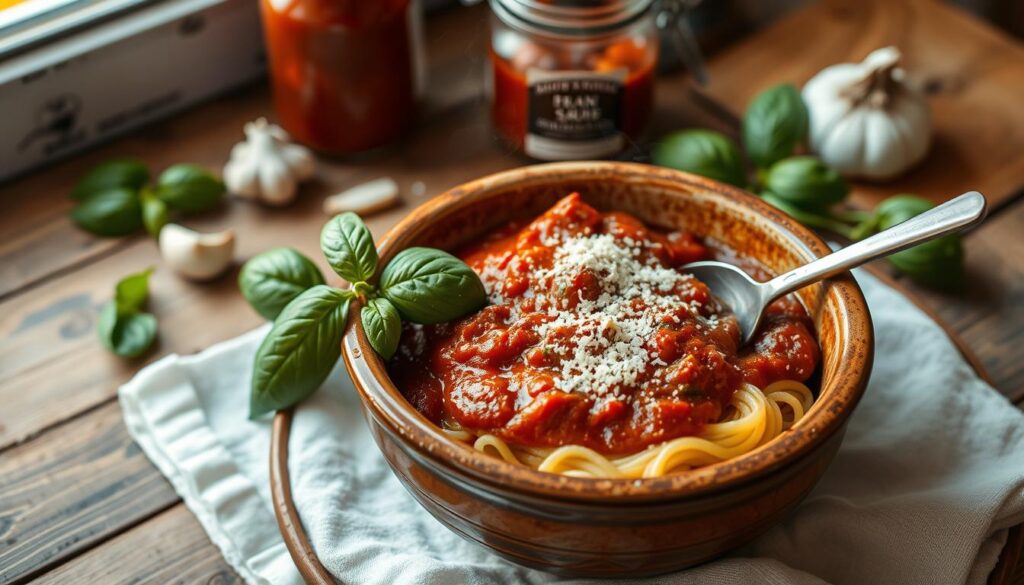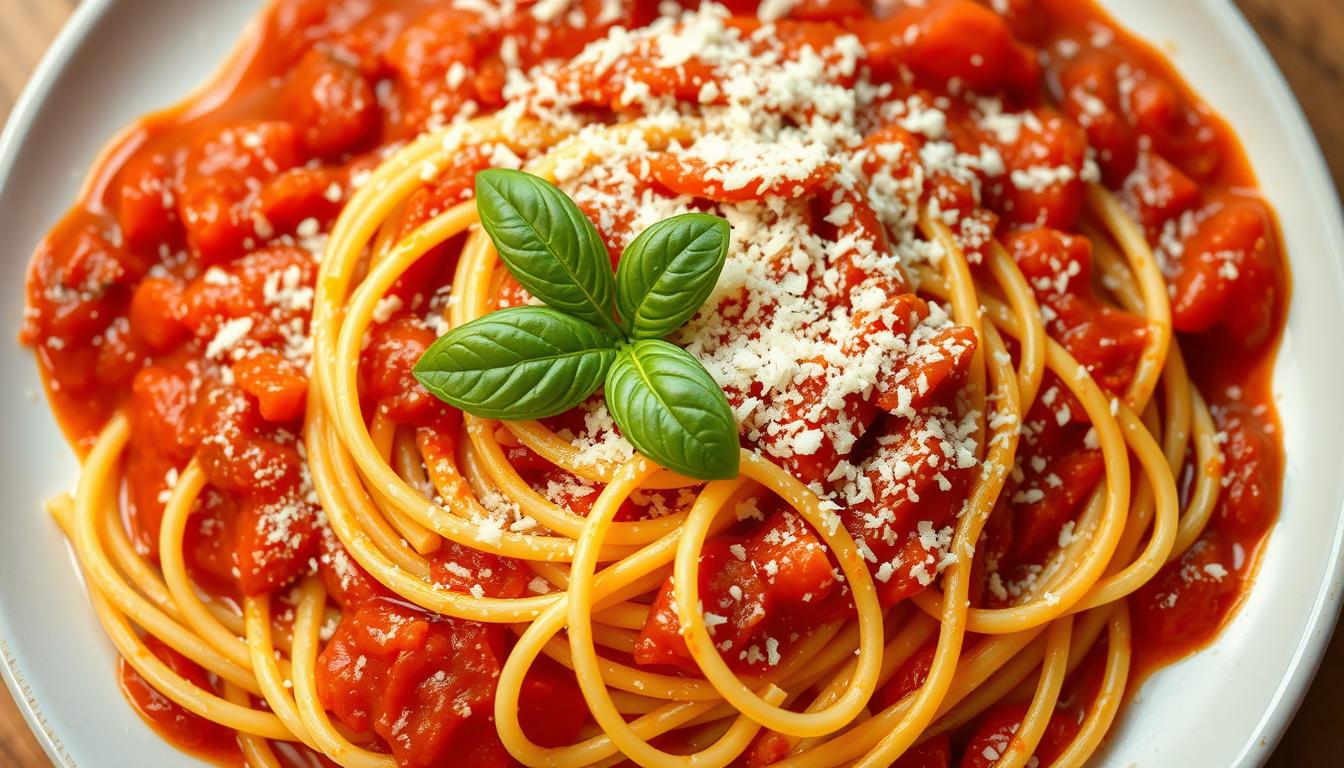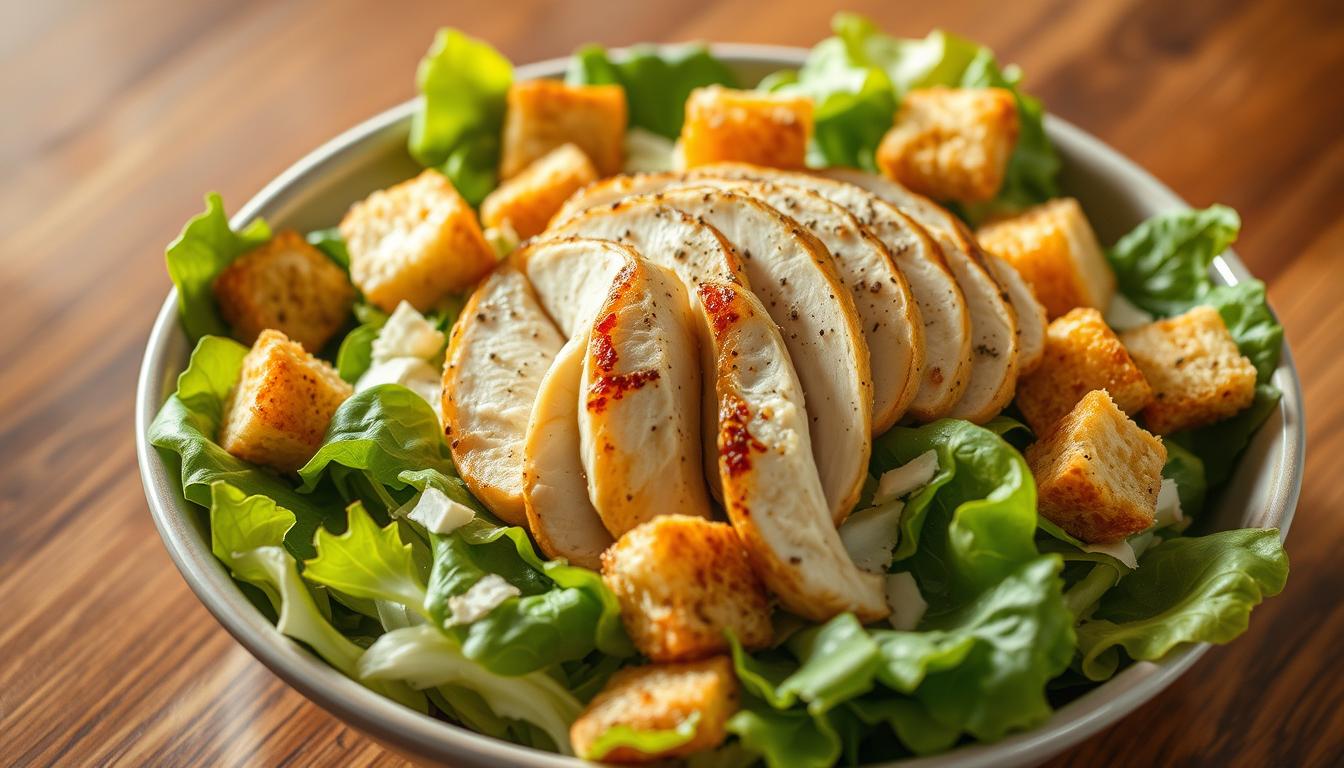Are you tired of cooking the same old spaghetti dish every night? Look no further! With a few simple hacks, you can transform leftovers into a delicious and quick meal.
Discover the secret to making a mouth-watering spaghetti sauce in just 15 minutes using your leftover ingredients. This article will guide you through the process, providing you with practical tips and tricks to create a culinary masterpiece.
Key Takeaways
- Create a quick spaghetti sauce using leftover ingredients.
- Learn simple hacks to transform your leftovers into a delicious meal.
- Get inspired by quick meal ideas that are perfect for busy weeknights.
- Make the most of your leftovers and reduce food waste.
- Enjoy a stress-free cooking experience with our expert tips.
The Magic of Quick Homemade Spaghetti Sauce
Transforming leftovers into homemade spaghetti sauce is an easy and economical way to elevate your meals. You’ll reduce food waste while creating a rich and flavorful sauce that’s far superior to store-bought alternatives.
Why Homemade Beats Store-Bought Every Time
Homemade spaghetti sauce stands out from its store-bought counterpart in several key ways. Firstly, homemade sauce is fresher and contains fewer preservatives, making it a healthier option for you and your family. Additionally, homemade sauce allows you to customize the flavor to your liking, whether you prefer a tangy, spicy, or herb-infused taste. This level of personalization is simply not possible with commercial products.
A comparison of homemade versus store-bought spaghetti sauce reveals significant differences in ingredients, taste, and nutritional value. The table below highlights these differences:
| Aspect | Homemade Spaghetti Sauce | Store-Bought Spaghetti Sauce |
|---|---|---|
| Ingredients | Fresh, customizable | Preserved, standardized |
| Taste | Rich, personalized flavor | Uniform, less vibrant |
| Nutritional Value | Lower sodium, fewer preservatives | Higher sodium, more preservatives |
The Economic and Flavor Benefits of Using Leftovers
Utilizing leftovers to make homemade spaghetti sauce not only reduces food waste but also offers significant economic benefits. By repurposing last night’s dinner into tomorrow’s sauce, you’re stretching your food budget further. Moreover, leftovers bring a depth of flavor to your sauce that would be hard to achieve with fresh ingredients alone. For instance, a roasted vegetable or a piece of grilled meat can add complexity and richness that elevates your sauce from good to great.
The practice of using leftovers in cooking is both environmentally friendly and cost-effective, making it a win-win for home cooks. By embracing this approach, you’ll not only save money but also discover new flavors and textures to enhance your meals.
Essential Base Ingredients for Your 15-Minute Spaghetti Sauce
To whip up a tasty spaghetti sauce in no time, you’ll need to stock up on some crucial pantry staples and fresh components. The right ingredients can make all the difference in the flavor and quality of your sauce.
Pantry Staples You’ll Need
Having the right pantry staples is essential for a quick and delicious spaghetti sauce. These include tomato products, herbs, spices, and seasonings.
Tomato Products and Alternatives
Canned crushed tomatoes, tomato paste, or fresh tomatoes can be used. For alternatives, consider roasted red peppers or sun-dried tomatoes for added depth.
Herbs, Spices, and Seasonings
Essential herbs like basil, oregano, and thyme, along with spices such as garlic powder and onion powder, enhance the flavor. Salt and pepper are must-haves for seasoning.
Fresh Components That Make a Difference
Fresh ingredients can elevate your spaghetti sauce from good to great. Consider adding aromatics and optional fresh herbs and vegetables.
Aromatics: Garlic, Onions, and More
Sauteed garlic and onions form a flavorful base. You can also add other aromatics like carrots and celery for added complexity.
Optional Fresh Herbs and Vegetables
Fresh basil, parsley, or other herbs can be added towards the end of cooking. Some vegetables, like bell peppers or mushrooms, can also be included for extra flavor and nutrition.
Kitchen Tools That Speed Up Your Sauce Preparation
Having the appropriate kitchen utensils and gadgets can significantly cut down your sauce preparation time. With the right tools, you can efficiently chop, sauté, and simmer your way to a delicious spaghetti sauce.
Must-Have Utensils and Equipment
To start, you’ll need some basic yet essential kitchen tools. These include:
- A large saucepan for simmering your sauce
- A cutting board for chopping vegetables and herbs
- A chef’s knife for efficient chopping
- A wooden spoon or silicone spatula for stirring
These utensils are staples in any kitchen and will help you prepare your sauce base efficiently.
Time-Saving Gadgets Worth Considering
For those looking to save even more time, consider investing in some time-saving gadgets. These can include:
- An immersion blender for blending your sauce right in the pot
- A food processor for quickly chopping ingredients
- A garlic press for effortless garlic preparation
By incorporating these gadgets into your sauce preparation routine, you can significantly reduce your overall cooking time while maintaining flavor and quality.
Step-by-Step: Creating Your 15-Minute Spaghetti Sauce
Transforming leftovers into a delicious spaghetti sauce is easier than you think, and it all starts with a simple step-by-step guide. By following these straightforward steps, you’ll be able to create a rich and flavorful sauce in no time.
Preparing Your Sauce Base
To begin, you’ll need to prepare your sauce base. Start by heating a couple of tablespoons of olive oil in a large saucepan over medium heat. Add a small onion, finely chopped, and sauté until it’s translucent. Then, add a couple of cloves of minced garlic and cook for another minute, stirring constantly to prevent burning.
Next, pour in a can of crushed tomatoes. You can use fresh tomatoes if they’re in season, but canned tomatoes are a convenient and flavorful alternative. Add a pinch of salt to bring out the flavors, and stir well to combine.
Adding and Incorporating Leftovers
Now it’s time to add your leftovers. This is where you can get creative and make the sauce your own. Some great options include:
- Roasted vegetables: Chopped bell peppers, zucchini, or eggplant can add depth and texture.
- Cooked meats: Shredded chicken, diced beef, or crumbled sausage can enhance the flavor.
- Mushrooms: Sautéed or roasted mushrooms can add an earthy flavor.
If you have leftover sautéed vegetables, like those from our Healthy Veggie Stir Fry recipe, you can add a rich flavor and extra nutrients to your spaghetti sauce.
Simply chop or shred your leftovers into manageable pieces and add them to the saucepan. Stir well to combine, ensuring that the leftovers are fully incorporated into the sauce base.
Final Seasoning and Adjustments
Once you’ve added your leftovers, it’s time to season the sauce. Taste it and adjust the seasoning as needed. You can add herbs like basil or oregano, a pinch of sugar to balance the acidity, or a sprinkle of red pepper flakes for some heat.
Finally, let the sauce simmer for a few minutes to allow the flavors to meld together. Your 15-minute spaghetti sauce is now ready to be enjoyed!
Best Leftovers to Transform Into Delicious Spaghetti Sauce
Transforming leftovers into a mouth-watering spaghetti sauce is not only economical but also a creative way to reduce food waste. The key is to identify the right ingredients that can blend well with tomatoes and enhance the flavor of your sauce.
Meat Options: From Roast Chicken to Meatloaf
Meat leftovers are an excellent addition to spaghetti sauce, adding depth and richness. Here are some options:
Red Meat Leftovers
Red meat leftovers like roast beef or lamb can be shredded or chopped and added to your sauce. Beef is particularly popular as it blends well with tomatoes and herbs.
Poultry and Other Proteins
Poultry like roast chicken or turkey can be used, too. Simply shred the meat and sauté it with some onions and garlic before adding it to your sauce. Other proteins, like sausages or meatballs, can also be incorporated.
Vegetable Leftovers That Shine
Vegetable leftovers can add a burst of flavor and nutrients to your spaghetti sauce. Consider using:
Roasted and Grilled Vegetables
Roasted vegetables like bell peppers, zucchini, or eggplant can be blended into your sauce for added depth. Grilled vegetables can also be used, providing a smoky flavor.
Steamed and Sautéed Vegetables
Steamed or sautéed vegetables such as spinach, carrots, or mushrooms can be added towards the end of cooking to preserve their texture and flavor.
Unexpected Ingredients That Work Surprisingly Well
Some unexpected ingredients can surprisingly enhance your spaghetti sauce. For instance, a bit of leftover mashed potato can add thickness, while chopped olives or artichoke hearts can introduce a unique flavor dimension.
By creatively using leftovers, you can not only reduce food waste but also create a rich and varied spaghetti sauce that’s full of flavor.
Sweet potato toppings, like those in our Easy Crispy Sweet Potato Skins recipe, can be incorporated for a unique flavor and interesting texture
15-Minute Spaghetti Sauce Hacks That Will Transform Your Leftovers
Unleash the flavor potential of your leftovers with our top tips for a quick and delicious spaghetti sauce. These hacks are designed to elevate your leftover game and turn them into a mouth-watering 15-minute spaghetti sauce.
Flavor-Boosting Shortcuts
Boosting the flavor of your spaghetti sauce can be achieved with a few simple shortcuts. One of the most effective ways is to use umami-rich additions. Umami is the fifth taste, in addition to sweet, sour, salty, and bitter, and it adds depth and complexity to your sauce.
Umami-Rich Additions
Some umami-rich ingredients you can add to your spaghetti sauce include mushroom broth, soy sauce, and anchovies. These ingredients are packed with umami flavor and can enhance the overall taste of your sauce.
Texture-Enhancing Techniques
Texture plays a crucial role in the overall enjoyment of your spaghetti sauce. To enhance the texture, you can use various techniques such as blending or simmering. Blending a portion of your sauce can create a creamy texture, while simmering can help thicken the sauce to your liking.
A comparison of different texture-enhancing techniques is shown in the table below:
| Technique | Description | Result |
|---|---|---|
| Blending | Blend a portion of the sauce | Creamy texture |
| Simmering | Simmer the sauce for a longer period | Thickened sauce |
| Reducing | Reduce the sauce by cooking off excess liquid | Intensified flavor |
Color and Presentation Tricks
The presentation of your spaghetti sauce can also be enhanced with a few simple tricks. Adding a sprinkle of fresh herbs or a drizzle of olive oil can add color and visual appeal to your dish. You can also use a microgreens garnish to add a pop of color.

Customizing Your Sauce for Different Dietary Needs
With a few simple tweaks, you can enjoy your spaghetti sauce regardless of dietary restrictions. Customizing your sauce not only makes it more inclusive but also opens up a world of flavors and possibilities.
Vegetarian and Vegan Adaptations
For vegetarians and vegans, the key is to focus on plant-based ingredients. You can easily replace meat with sautéed mushrooms, eggplant, or tofu for added protein and texture. When using vegetable broth, ensure it’s free from animal products for vegan diets. Nutritional yeast can be a great addition to give your sauce a cheesy flavor without the dairy.
Vegetarian/Vegan Sauce Comparison:
| Ingredient | Vegetarian Option | Vegan Option |
|---|---|---|
| Protein Source | Eggs or dairy-based cheese | Tofu, tempeh, or seitan |
| Broth | Vegetable or chicken broth | Vegetable broth (ensure it’s vegan) |
| Cheese Flavor | Parmesan or mozzarella | Nutritional yeast |
Gluten-Free and Low-Carb Options
For those on a gluten-free diet, it’s essential to be mindful of the ingredients used in your sauce. Some store-bought tomato products may contain gluten, so opt for gluten-free tomato paste or crushed tomatoes. For a low-carb version, reduce or eliminate added sugars and focus on tomatoes, vegetables, and herbs. You can also use low-carb sweeteners if needed.
By making these adjustments, you can create a spaghetti sauce that caters to various dietary needs without compromising on flavor.
Storage Solutions for Your Homemade Sauce
Proper storage is crucial for maintaining the quality and safety of your homemade spaghetti sauce. Whether you plan to use it within a few days or save it for later, understanding the best storage methods is essential.
Refrigeration Tips and Timeline
For short-term storage, refrigeration is a suitable option. Your homemade sauce can be safely stored in the refrigerator for up to 3 to 5 days. To maintain its quality, store it in an airtight container, such as a glass jar with a tight-fitting lid. Always check the sauce for any signs of spoilage before consuming it, such as off smells or mold.
Freezing Methods for Future Meals
For longer storage, freezing is an excellent method. Freezing your homemade spaghetti sauce can preserve its flavor and nutritional value for several months. To freeze effectively, portion the sauce into airtight containers or freezer bags, making sure to remove as much air as possible before sealing.
Portion Control for Freezing
Dividing your sauce into smaller portions (e.g., 1 or 2 cups) before freezing makes it easier to thaw only what you need. This approach also helps in reducing food waste.
Thawing and Reheating Safely
When you’re ready to use your frozen sauce, thaw it overnight in the refrigerator or thaw it quickly by submerging the container in cold water. Reheat the sauce to an internal temperature of at least 165°F (74°C) to ensure food safety.
| Storage Method | Duration | Tips |
|---|---|---|
| Refrigeration | 3-5 days | Use airtight containers |
| Freezing | Several months | Remove air before sealing |

Creative Ways to Serve Your 15-Minute Sauce Beyond Pasta
Unleash the full potential of your 15-minute spaghetti sauce in various culinary delights. While it’s a classic pairing with pasta, its uses extend far beyond, offering a world of flavors for different dishes.
As a Base for Other Main Dishes
Your 15-minute sauce can be a fantastic base for other main courses, adding depth and richness to various recipes.
Pizza and Flatbread Applications
Use your sauce as a pizza base for a quick and delicious homemade pizza. Simply spread it over your pizza dough, add your favorite toppings, and bake until golden. It’s also great on flatbreads, providing a burst of flavor.
Casseroles and Baked Dishes
Incorporate your sauce into casseroles and baked dishes for an extra layer of flavor. It pairs well with vegetables, meats, and cheeses, making it a versatile ingredient for recipes like lasagna or eggplant parmesan.
Unconventional Pairings That Work
Experiment with unconventional pairings to discover new favorite dishes.
Breakfast and Brunch Ideas
Use your sauce as a topping for breakfast dishes like shakshuka or as a sauce for breakfast burritos, adding a rich, tangy flavor.
Appetizers and Snacks
It can also be used as a dip for breadsticks or as a topping for appetizer crostini, making for a delicious and easy snack.
| Dish | Application | Tips |
|---|---|---|
| Pizza | Base Sauce | Use on pizza dough, add toppings, and bake |
| Casseroles | Flavor Layer | Mix with other ingredients and bake |
| Shakshuka | Topping | Add eggs and bake until set |
Nutritional Benefits of Your Homemade Leftover Sauce
By utilizing leftovers to create a spaghetti sauce, you’re not only saving time but also enhancing your meal’s nutritional value. Homemade leftover sauce can be a powerhouse of nutrients, depending on the ingredients used.
Comparing Homemade vs. Commercial Options
When comparing homemade leftover sauce to commercial options, the differences in nutritional content become apparent. Commercial sauces often contain high levels of sodium and preservatives, whereas homemade sauces can be made with fresh ingredients and less salt. This control over ingredients allows for a healthier product.
For a detailed breakdown of the nutritional values of homemade spaghetti sauce, you can explore this FatSecret resource.
Boosting the Nutritional Profile Further
To further enhance the nutritional profile of your homemade sauce, consider adding vegetables rich in antioxidants or using herbs for flavor instead of salt. You can also opt for lean proteins and healthy oils to increase the sauce’s nutritional value.
For additional tips and insights into the nutritional benefits of spaghetti, check out this Listonic article.
Conclusion: Mastering the Art of Quick, Delicious Spaghetti Sauce
Mastering the art of creating quick and delicious spaghetti sauce from leftovers can transform your meal prep and elevate your cooking skills. By applying the hacks and techniques explored in this article, you can create a variety of mouth-watering sauces in just 15 minutes.
The key to Mastering Spaghetti Sauce lies in understanding how to effectively utilize leftovers, from roast chicken to vegetable scraps, and combining them with essential pantry staples. This approach not only reduces food waste but also results in Quick, Delicious Meals that are both satisfying and nutritious.
As you continue to experiment with different ingredients and flavor profiles, you’ll find that creating delicious spaghetti sauce becomes second nature. With practice, you’ll be able to whip up a tasty sauce that’s sure to please even the pickiest eaters, making mealtime a breeze and leaving you more time to enjoy the things you love.


